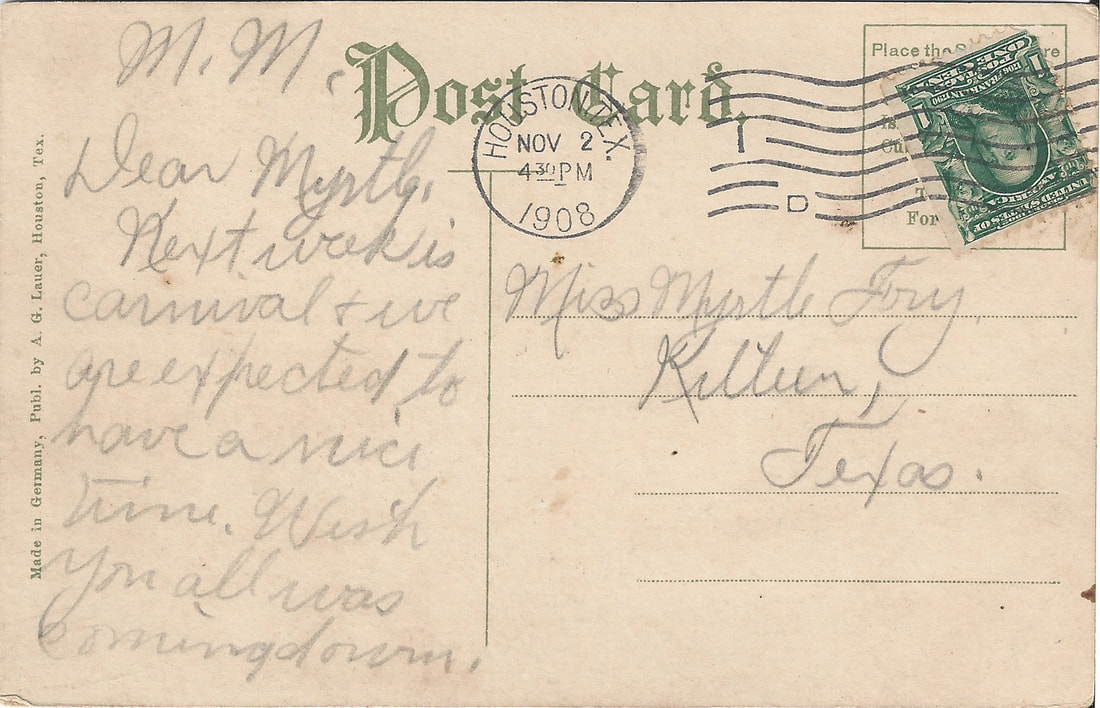St. Joseph's Infirmary
|
15 September 1910: The Sisters of the Incarnate Word founded St. Joseph Parish in 1880 to serve the German community in the 6th Ward. In 1895 they built the Saint Joseph Infirmary in a residential neighborhood on the southern outskirts of Houston. Crawford, Pierce, LaBranch and Calhoun (now St. Joseph Parkway) streets encompassed the site, which included the convent (left), private rooms (center), male wards (right), and behind these buildings, female wards and, remarkable for the time, a negro ward in an otherwise white hospital.
|
9 August 2013: Taken from the shadow of the Pierce Elevated, this shot from Crawford and Pierce toward the northwest hints at the many construction projects over the years that have made St. Joseph Hospital one of the most active centers outside the complex near Hermann Park. Before the city-sized Houston Medical Center, St. Joseph was the biggest hospital in Houston, and was once called "The Birthplace of Houston" for the number of births happening there.
|
|
Postmarked: 2 November 1908; Houston, Texas
Stamp: 1c Blue Green Ben Franklin #300 To: Miss Myrtle Fry, Killeen, Texas. Message: M. M. Dear Myrtle, Next week is carnival & we are expected to have a nice time. Wish you all was coming down. |
M.M. does not reveal enough information to establish his or her identity, but in view of the fact that the card was a part of a lot consisting of 14 cards from Ethel McCutcheon to Myrtle Fry, with 7 other cards from others, it seems likely MM was in the orbit of Ethel’s family. Those family members with the initials MM include Margaret Knox McCutcheon (1861-1940), Ethel’s mother. At least until some kind of handwriting confirmation can be made, she will serve as a stand-in for the author of the card. Mrs. McCutcheon was a Scottish immigrant who came to America as a young married girl 20 years old. She arrived in New York on the S.S. City of Montreal from Liverpool, UK on 5 Mar 1881 with her husband, 33 year-old Henry Lister McCutcheon.
Margaret was born in 1860 at Bonhill, Dunbarton, Scotland, the daughter of William Knox and Margaret Millen. Henry Lister McCutcheon was the son of Jane Little and Henry Lister McCutcheon, Sr., an iron worker of Carlisle, Cumberland, England. Bonhill is a small Scotch village on the River Leven flowing between Loch Lomond and the River Clyde while Carlisle is an ancient town more than 100 miles to the southeast. Margaret may have been drawn to Carlisle by work in the cotton mills and there met Henry. With so many workers drawn to the area crammed into limited housing, conditions were unhealthy and riots for better conditions were common. Many emigrated out, as did Henry and Margaret through Liverpool to New York. They settled in Texas where Henry, his older brother Joshua and an associate formed an agricultural implements company, John Thompson & Co. in Austin where they were to be found 1885-1887. Five years later they relocated to Houston, Henry finding work at Anheuser-Busch Brewing Company and Joshua set up an office as a merchandising agent. Joshua died in 1905 of Bright’s Disease, and Henry Lister died in 1913; both were buried in Hollywood Cemetery, Houston, TX. When Margaret was widowed, she remained in their house at 204 Bayou Street at Roanoke (now Clinton) in Houston’s fifth Ward. With her was her unmarried daughters Gertrude Belle and Ethel Agnes, as well as son John Lister McCutcheon (a daughter, Vivian Margaret had died in 1904 at age 12). Three blocks west was her other son, Henry Knox McCutcheon, who worked as a cooper (barrel maker) at Merchants & Planters Oil Company. Cotton-Seed Oil was a large industry then, taking the oil from cottons seeds that otherwise would be a waste product from the cotton ginning process. [Another cotton-seed oil merchant in the area was the Cale-Lane Oil Company]. When Margaret’s daughter Ethel married James Port McMillan in 1924 and moved to 705 Wayside in the new neighborhood of Magnolia Park, she brought her mother to live with her. Margaret died in 1940 and was interred in Hollywood Cemetery in the McCutcheon plot containing her husband, brother-in-law Joshua, and son John Lister McCutcheon who died in 1935. |

